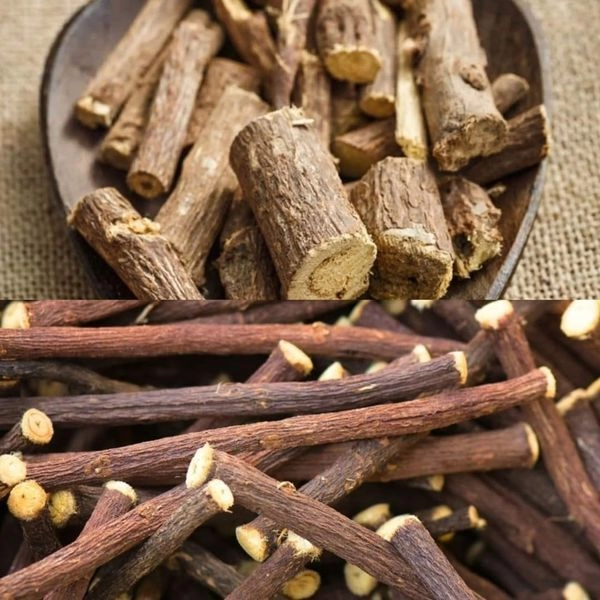Ayurveda has long celebrated two herbs for radiant, even-toned, resilient skin: Yashtimadhu (Glycyrrhiza glabra; licorice) and Manjistha (Rubia cordifolia). Rooted in classical texts and time-tested formulations, they work in complementary ways—Yashtimadhu calms and brightens, while Manjistha clarifies and purifies the blood (rakta), addressing skin concerns from the inside out.
What the classical texts say
1) Yashtimadhu (Licorice)
· Listed among “Varnya Mahakashaya”—the group of ten complexion-enhancing herbs—in Charaka Saṁhitā, Sūtrasthāna Chapter 4, where 50 “Mahākaśāya” (great herb groups) are enumerated and Varnya dravyas are singled out for improving varṇa (complexion/skin tone).
· Classical compendia also place Yashtimadhu in other beneficial categories (e.g., Jīvanīya, Sandhanīya, Varnya, Kāntya), underscoring tissue healing and luster. (See scholarly summaries collating Charaka, Suśruta, Vāgbhaṭa, Bhāvaprakāśa.)
Ayurvedic pharmacology (Dravyaguṇa) traditionally attributed to Yashtimadhu:
· Rasa (taste): Madhura (sweet)
· Guṇa (qualities): Guru (nourishing), Snigdha (unctuous)
· Vīrya (potency): Śīta (cooling)
· Vipāka: Madhura
· Doṣa action: Pacifies Pitta and Vāta; supports Rasa/Rakta dhātu and skin luster (varṇa).
2) Manjistha
· Recognized as Varnya (complexion-supportive) in classical literature and repeatedly cited for Raktaśodhana/Raktaprasādana (blood purification and pacification)—a central strategy in skin disorders. Reviews of the primary texts (Charaka, Suśruta, Aṣṭāṅga) and nighaṇṭus consistently document Manjistha’s place here.
· Suśruta Saṁhitā (core surgical/therapeutic treatise) and Aṣṭāṅga Hṛdaya include Manjistha in therapeutic groups addressing Pitta and Rakta aggravations—patterns classically tied to erythema, pigmentation changes, acneiform lesions, and inflammatory dermatoses.
Ayurvedic pharmacology (Dravyaguṇa) traditionally attributed to Manjistha:
· Rasa: Tikta (bitter), Kaṣāya (astringent)
· Guṇa: Laghu (light), Rūkṣa (dry)
· Vīrya: Uṣṇa (warming)
· Vipāka: Kaṭu
· Doṣa action: Pacifies Pitta and Kapha; cleanses Rakta → helps with discoloration (vyanga), blemishes, and inflammatory skin states.
Why these two together?
Classical logic pairs a Varnya, pitta-soothing demulcent (Yashtimadhu) with a Rakta-cleansing, pitta-pacifying alterative (Manjistha). One calms and nourishes the skin barrier; the other clears the medium (blood/lymph) that feeds the skin.
Skin benefits—explained through Ayurvedic principles
1. Brightening & Even Tone (Varnya karma): Yashtimadhu’s inclusion in Varnya Mahakashaya links it directly to improved varṇa (complexion), helping reduce dullness and unevenness.
2. Redness, Heat, and Irritation (Pitta-śamana + Rasa/Rakta support): Sweet taste and cooling potency of Yashtimadhu pacify heat and irritation; Manjistha addresses the root by clarifying Rakta—Ayurveda’s primary locus for inflammatory skin patterns.
3. Blemishes, Spots, and Pigmentation (Vyanga, Nīlikā, etc.): Classical grouping of both herbs under Varnya and Rakta-modulating actions underpins their traditional use for discoloration and post-inflammatory marks.
4. Support for Wound/Barrier Repair (Sandhanīya, Ropaṇa): Compilations of Charaka’s categories and later classical reviews record healing/ropaṇa attributes for Yashtimadhu—useful where the barrier is compromised.
How to use them in a modern routine (Ayurveda-aligned)
Note: Always patch test first. If you have conditions like hypertension or are pregnant/breast-feeding, consult a clinician before internal licorice.
External (bahya) use
A. Soothing Brightening Lepa (face mask) – “Varnya + Pitta-śamana”
Base: 1 tsp Yashtimadhu churna + ½ tsp Manjistha churna
Anupāna (vehicle): For redness/heat → rose water or milk; for oily/acneic → warm water or aloe gel.
Method: Mix to a soft paste, apply thinly, leave 10–15 min, rinse gently.
Frequency: 2–3×/week.
B. Spot Lepa for Marks/Uneven Tone (Vyanga-pradhāna)
¼ tsp Yashtimadhu + ¼ tsp Manjistha + a few drops of honey (madhura, yogavāhi) → dab on marks nightly for 15 min, then wash.
C. Ubtan-style Cleanser (daily or alternate-day)
Equal parts fine Yashtimadhu, Manjistha, and Santala/Chandana (if available), sifted.
Take ½–1 tsp with water/rose water to form a thin paste; massage lightly and rinse.
D. Taila (herbal oil) layering
Use a neutral oil (sesame for vāta-prone dry skin, sunflower for pitta-prone, or light coconut in humid climates).
Post-cleanse, apply 2–3 drops; then a pea-sized gel-cream.
Classical “Yashtimadhu taila” traditions support skin repair and comfort.
Internal (ābhyantara) support (optional; under guidance)
· Manjistha kwātha (decoction) or sattva capsules are traditionally used for Rakta-śodhana and pitta balance in skin disorders.
· Yashtimadhu internally is demulcent and pitta-pacifying, but use cautiously if you have hypertension, fluid retention, or are pregnant (licorice can raise blood pressure in susceptible individuals).
Simple 4-week starter plan
Week 1–2:
· Morning: Ubtan cleanser → light moisturizer + sunscreen
· Night: Lepa (mask) 2–3×/week; on other nights, cleanse + a few drops of oil
Week 3–4:
· Introduce spot lepa nightly on marks; keep mask to 2×/week.
· Observe changes in redness, texture, and post-blemish marks.
Formulation tips (the Ayurvedic way)
Match the vehicle to your doṣa/season:
· Pitta-predominant/redness: rose water, milk, sandalwood water
· Kapha-oily/acneic: warm water, aloe gel
· Vāta-dry/sensitive: milk, yogurt, or a few drops of sesame/sweet almond oil
Pair wisely:
· Yashtimadhu + Chandana for extra cooling/soothing
· Manjistha + Sarivā in heat; Manjistha + Nimba for oily/congested skin (use sparingly if very dry)
Safety & quality
· Source food-/pharmacopeia-grade powders from reputable Ayurvedic suppliers.
· Patch test every new blend (jawline/behind ear for 24–48 hrs).
· Licorice caution: Avoid long-term high-dose internal use if hypertensive or on medications affecting potassium/cortisol; consult your physician.
References from classical Ayurvedic literature (and scholarly compendia)
· Charaka Saṁhitā, Sūtrasthāna 4—enumeration of the 50 Mahākaśāyas, including Varnya Mahākaśāya; Yashtimadhu cited for enhancing complexion.
· Yashtimadhu’s classical groupings (Jīvanīya, Sandhanīya, Varnya, Kāntya) consolidated from Charaka/Suśruta/Vāgbhaṭa/Bhāvaprakāśa by academic reviews.
· Manjistha as Varnya and Rakta-modulating in Charaka & allied treatises; customary indication for kustha/skin disorders, vyanga/discolorations and Rakta-śodhana.
· Suśruta Saṁhitā (classical translation resource) and Aṣṭāṅga Hṛdaya (canonical text) include Manjistha in therapeutic groups concerned with Pitta/Rakta conditions relevant to dermatology.
· Contemporary Ayurvedic reviews on Varnya dravyas (including Yashtimadhu and Manjistha) provide chapter/verse mapping for classical claims and practical lepa uses.
FAQ
Q1. Can I use Yashtimadhu and Manjistha daily?
Yes—use gentle daily formats (cleanser/toner-style splash). Keep mask/spot lepa to 2–4×/week based on sensitivity.
Q2. Will they help with PIH (post-inflammatory hyperpigmentation)?
They’re classically indicated for varṇa and Rakta balance, a traditional rationale for uneven tone and marks; consistency matters (8–12 weeks).
Q3. Can I combine them with vitamin C or acids?
Yes—use on alternate nights at first. If you use strong actives, prefer the herbal lepa on off-days to buffer sensitivity.
Q4. Are these safe in pregnancy?
Topical use is generally mild; internal licorice is best avoided unless prescribed. Always consult your practitioner.
Bottom line
In classical Ayurveda, Yashtimadhu is a go-to Varnya herb to soothe, brighten, and repair, while Manjistha is the archetypal Rakta-cleanser to clarify from within. Together, they align outer care with inner balance—Ayurveda’s signature path to lasting skin health.

